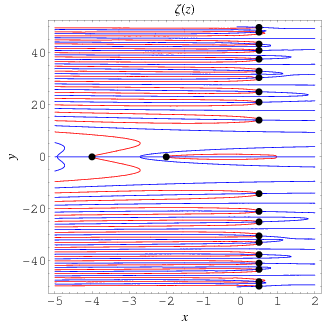Zeros Dr. Riemann..................0 + 0 = 0....................0 * 0 = 0...................2 + 2 = 4..........2 * 2 = 4.....................2 and 0..............are the only two numbers.........whose sum and product are the same number..........two primes seen.................in 2.7.....................two unseen in the space in between................3 and 5....................the 2nd divided by the 1st is close to the golden ratio,,,,,,,,,,,,,,,,,,2/1 and 1/2..............reflex sym..........spin........a line at 1/2...................single digits and double digits................embodied in a single fraction.....1/2.............fractal patterns galore......
14i + 21i = 35i.......................the seen and unseen..........real and imaginary...........2.7...........is how e starts out.......................2, 3, 5, 7...............all four single digit primes...........................all included in the space from 2 to 7...........if u include end points...........of 2 and 7........
The plots above show the real and imaginary parts of  plotted in the complex plane together with the complex modulus of  . As can be seen, in right half-plane, the function is fairly flat, but with a large number of horizontal ridges. It is precisely along these ridges that the nontrivial zeros of  lie.  The position of the complex zeros can be seen slightly more easily by plotting the contours of zero real (red) and imaginary (blue) parts, as illustrated above. The zeros (indicated as black dots) occur where the curves intersect.  The figures above highlight the zeros in the complex plane by plotting  (where the zeros are dips) and  (where the zeros are peaks).  The above plot shows  for  between 0 and 60. As can be seen, the first few nontrivial zeros occur at the values given in the following table (Wagon 1991, pp. 361-362 and 367-368; Havil 2003, p. 196; Odlyzko), where the corresponding negative values are also roots. The integers closest to these values are 14, 21, 25, 30, 33, 38, 41, 43, 48, 50, ... (OEIS A002410). The numbers of nontrivial zeros less than 10,  ,  , ... are 0, 29, 649, 10142, 138069, 1747146, ... (OEIS A072080; Odlyzko).
 | Sloane |  |
| 1 | A058303 | 14.134725 |
| 2 | | 21.022040 |
| 3 | | 25.010858 |
| 4 | | 30.424876 |
| 5 | | 32.935062 |
| 6 | | 37.586178 |
|
 The position of the complex zeros can be seen slightly more easily by plotting the contours of zero real (red) and imaginary (blue) parts, as illustrated above. The zeros (indicated as black dots) occur where the curves intersect.
The position of the complex zeros can be seen slightly more easily by plotting the contours of zero real (red) and imaginary (blue) parts, as illustrated above. The zeros (indicated as black dots) occur where the curves intersect.  The figures above highlight the zeros in the complex plane by plotting
The figures above highlight the zeros in the complex plane by plotting  The above plot shows
The above plot shows
No comments:
Post a Comment